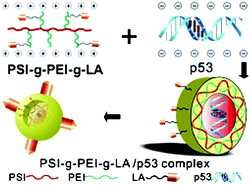In this paper, a highly efficient gene transfer vector with hepatocyte-targeted function, galactosylated poly(L-succinimide)-g-polyethylenimine-g-lactobionic acid (PSI-g-PEI-g-LA), was synthesized by conjugating lactobionic acid (LA) to biodegradable cationic PSI-g-PEI polymers. The physicochemical properties of PSI-g-PEI-g-LA including buffer capability, plasmid DNA (pDNA) binding ability, cytotoxicity, zeta potential and complex size were explored. Dynamic light scattering (DLS) reveals that PSI-g-PEI-g-LA can compactly condense pDNA into nano-sized particles with a hydrodynamic diameter of 95–175 nm. PSI-g-PEI-g-LA exhibits much higher cell-biocompatibility compared to PSI-g-PEI and PEI. The hepatocyte-targeted function was demonstrated by comparative studies on three polymeric vectors including PSI-g-PEI-g-LA, PSI-g-PEI and PEI25k. The transfection efficiency was evaluated in two different cell lines including asialoglyco protein receptor (ASGP-R) bearing HepG2 cells and ASGP-R-lacking HeLa cells. The in vitro transfection tests using different reporter genes indicate that PSI-g-PEI-g-LA displays higher transfection activity in HepG2 cells due to the specific interaction between LA segments and its ASGP-R on HepG2 cells compared with PSI-g-PEI and PEI. In contrast, the three polymers exhibit similar transfection activity in HeLa cells. PSI-g-PEI-g-LA displays better serum-tolerant transfection ability. Based on these analyses, PSI-g-PEI-g-LA was used as the vector to mediate the transfection of a tumor-suppressor gene p53. By means of western blotting analysis, flow cytometry and confocal laser scanning microscopy techniques, considerably high p53 gene expression and consequently strong p53-inducing apoptosis of HepG2 cells are distinctly observed.

You have access to this article
 Please wait while we load your content...
Something went wrong. Try again?
Please wait while we load your content...
Something went wrong. Try again?


 Please wait while we load your content...
Please wait while we load your content...